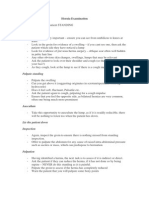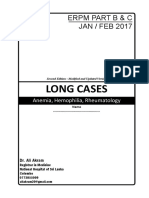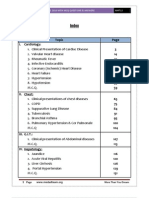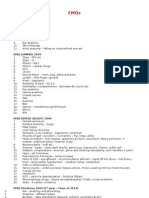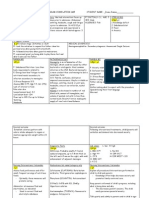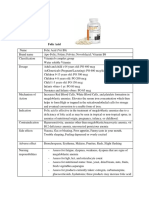EMQs For Medical Students Volume 3 2e
EMQs For Medical Students Volume 3 2e
Uploaded by
PasTestBooksCopyright:
Available Formats
EMQs For Medical Students Volume 3 2e
EMQs For Medical Students Volume 3 2e
Uploaded by
PasTestBooksOriginal Title
Copyright
Available Formats
Share this document
Did you find this document useful?
Is this content inappropriate?
Copyright:
Available Formats
EMQs For Medical Students Volume 3 2e
EMQs For Medical Students Volume 3 2e
Uploaded by
PasTestBooksCopyright:
Available Formats
EMQs for Medical Students
Volume 3 Practice Papers
Second Edition
Contents
List of contributors Preface Introduction Glossary Normal values Paper 1 Paper 2 Paper 3 Paper 4 Paper 5 Paper 6 Paper 7 Paper 8 Paper 9 Paper 10 Radiology images Index
vi vii ix xi xv 1 33 67 101 135 169 205 239 273 307 343 357
PAPER 1
Paper 1 Questions
1. THEME: UREA, ELECTROLYTES AND CREATININE
Na+ (mmol/l) A B C D E F G H I J K 105 113 115 127 128 129 132 136 139 156 183 K+ (mmol/l 1.0 4.9 6.9 4.0 8.9 3.9 5.9 4.4 2.0 5.1 5.9 Urea (mmol/l 0.8 4.8 6.8 1.8 13.3 24.8 32.8 4.3 4.7 28.7 54.8 Creatinine ( mol/l) 29 89 91 57 139 101 809 86 87 155 369
The following patients have all presented with conditions leading to derangement of their urea and electrolytes (U&Es). Please choose the most appropriate set of results from the above list. You may use each option once, more than once or not at all. 1. A 64-year-old lifelong smoker presents to his GP with weight loss, increasing weakness and a recent cough associated with episodic fresh haemoptysis. On examination, he is unwell with obvious cushingoid features. 2. A 28-year-old Asian woman presents to her GP with a 3week history of a cough productive of thick, green sputum with occasional dark-red blood mixed into it. She also admits to having night sweats and weight loss.
EMQs FOR MEDICAL STUDENTS VOLUME 3
3. A 61-year-old man with a long history of alcohol abuse presents to his local Emergency Department with a large fresh haematemesis (>500 ml). His subsequent U&Es confirm that he has had an occult upper gastrointestinal bleed for some time prior to the haematemesis. 4. A 42-year-old woman with long-standing, poorly controlled type 1 diabetes is admitted to hospital with diabetic ketoacidosis. The FY1 doctor who takes her initial bloods is rung by the laboratory technician to tell her that the U&Es sample needs to be repeated as the original sample looks as if it has been taken proximal to an intravenous infusion. 5. A 71-year-old man with ischaemic cardiomyopathy presents to his GP with increasing weakness and malaise. The doctor notes that he has recently had losartan added to his ramipril.
PA P E R 1
2. THEME: ANAEMIA
A B C D E F G H I J Anaemia of chronic disease Aplastic anaemia Autoimmune haemolytic anaemia Vitamin B12 deficiency Iron deficiency Myelodysplasia Pancytopenia secondary to multiple myeloma Sickle-cell disease Sideroblastic anaemia Thalassaemia trait
The following patients have all presented with anaemia. Please choose the most appropriate cause from the above list. Each option may be used once, more than once or not at all. 1. A 73-year-old woman presents to her GP with lethargy and malaise. Of note, she has recently been placed on clopidogrel for the treatment of unstable angina. Her routine blood tests show: haemoglobin 6.8 g/dl, mean corpuscular volume (MCV) 68 fl, white cell count (WCC) 9.2 109/l, platelets 491 109/l; Na+ 136 mmol/l, K+ 3.9 mmol/l, urea 4.7 mmol/l, creatinine 88 mol/l. 2. A 79-year-old man, who has recently been started on phenytoin after neurosurgery, is re-admitted under the physicians with a severe pneumonia and is noted to have bleeding gums and heavy bruising over his limbs. Investigations reveal: haemoglobin 4.9 g/dl, MCV 88 fl, WCC 2.2 109/l, platelets 11 109/l. The blood film shows pancytopenia with few reticulocytes seen; a bone marrow trephine shows hypocellularity with increased fat spaces. 3. A 67-year-old woman is admitted to hospital with severe lumbar back pain associated with recurrent chest infections and general malaise. Investigations show: haemoglobin 3.9 g/dl, MCV 98 fl, WCC 1.9 109/l, platelets 27 109/l; Na+ 130 mmol/l, K+ 5.9 mmol/l, urea 24.4 mmol/l, creatinine 412 mol/l; erythrocyte sedimentation rate (ESR) 122 mm/h; corrected Ca2+ 3.37 mmol/l. 4. A 51-year-old Asian woman is seen in the pre-operative assessment clinic prior to her planned breast lumpectomy. Routine investigations reveal: haemoglobin 10.3 g/dl, MCV 58 fl, WCC 5.5 109/l, platelets 369 109/l, ferritin 92 g/l. 5. An 83-year-old woman is admitted to hospital with a severe communityacquired pneumonia. Investigations reveal: haemoglobin 7.9 g/dl, MCV 102 fl, WCC 3.2 109/l, platelets 254 109/l. The blood film shows significant reticulocytosis. Cold IgM antibodies are later shown to be responsible.
EMQs FOR MEDICAL STUDENTS VOLUME 3
3. THEME: RESPIRATORY FAILURE
A B C D E F G H I J Asbestosis Asthma Chronic obstructive pulmonary disease (COPD) GuillainBarr syndrome Idiopathic pulmonary fibrosis Legionella pneumonia Mycoplasma pneumonia Pickwickian syndrome Pulmonary embolism Pulmonary oedema
The following patients have all presented with respiratory failure. Please choose the most appropriate cause from the above list. Each option may be used once, more than once, or not at all. (The arterial blood gases have all been taken on room air.) 1. A 71-year-old retired boiler lagger is referred to Medical Out-patients with a 6month history of worsening exertional dyspnoea. On examination, he is dyspnoeic at rest but does not have finger clubbing or cyanosis. Auscultation reveals bibasal fine inspiratory crepitations. His chest radiograph shows pleural and diaphragmatic plaques with diffuse lower-zone changes. The arterial blood gases show: pH 7.39, PaCO2 4.1 kPa, PaCO2 7.9 kPa, oxygen saturation 91%, HCO3 25 mmol/l, base excess 1.9 mmol/l. 2. An obese 61-year-old man presents to his GP with exertional dyspnoea, earlymorning headaches and daytime somnolence. Spirometry reveals an obstructive problem and the arterial blood gases show: pH 7.37, PaCO2 7.9 kPa, PaCO2 7.3 kPa, oxygen saturation 87%, HCO3 34 mmol/l, base excess 6.9 mmol/l. He improves with overnight nasal ventilation. 3. A 49-year-old woman presents in the Emergency Department with acute shortness of breath. On examination, she is peripherally shutdown, clammy, tachycardic and hypotensive. The arterial blood gases show: pH 7.13, PaCO2 3.5 kPa, PaCO2 7.9 kPa, oxygen saturation 89%, HCO3 15 mmol/l, base excess 7.3 mmol/l. Her chest radiograph shows alveolar shadowing in a batwing configuration. 4. A 35-year-old woman becomes acutely unwell, with shortness of breath and a dry, non-productive cough. Investigations reveal: Na+ 127 mmol/l, K+ 4.9 mmol/l, urea 7.4 mmol/l, creatinine 122 mol/l. Her chest radiograph is relatively unremarkable but the arterial blood gases show: pH 7.33, PaCO2 3.7 kPa, PaCO2 6.3 kPa, oxygen saturation 82%, HCO3 20 mmol/l, base excess 2.9 mmol/l. The diagnosis is later confirmed by urine antigen testing. 5. A 56-year-old man presents to his GP with a 4-month history of increasing exertional dyspnoea. On examination, he has marked clubbing of the fingernails and is short of breath on relatively mild exertion. Auscultation of his chest reveals fine inspiratory crepitations. Subsequent investigations confirm a restrictive pattern on spirometry.
PA P E R 1
4. THEME: ASCITES
A B C D E F G H I J Alcoholic cirrhosis Chronic hepatitis B infection Colonic carcinoma Constrictive pericarditis Ischaemic cardiomyopathy Ovarian carcinoma Pericarditis Peritoneal mesothelioma Renal-cell carcinoma Tuberculosis
The following patients have all presented with ascites. Please choose the most appropriate cause from the above list. Each diagnosis may be used once, more than once or not at all. 1. A 51-year-old woman presents to her GP with increasing abdominal swelling. Subsequent investigations reveal a grossly elevated Ca-125. Her chest radiograph is unremarkable but there are adenocarcinoma cells in the ascitic fluid. 2. A 49-year-old woman presents in the Emergency Department with increasing exertional dyspnoea and swelling of her abdomen and ankles. On examination, she has tar-stained fingers on her right hand, her pulse is 120 beats per minute (bpm) regular, and her blood pressure (BP) is 105/70 mmHg. Her jugular venous pressure (JVP) is elevated to the angle of her jaw but Kussmauls sign is negative. Her apex beat is grossly displaced into the posterior axillary line and she has a marked pansystolic murmur which is clearly heard throughout the praecordium. Her electrocardiogram (ECG) shows sinus rhythm 120 bpm, left axis deviation, and deep Q-waves in leads V1V4. 3. A 71-year-old retired docker presents to his GP with increasing abdominal swelling, lethargy and malaise. On examination, he is clinically anaemic and has gross ascites but no organomegaly, masses or lymphadenopathy. Abdominal computed tomography (CT) shows infiltration of the peritoneum and ascites. The diagnosis is later confirmed by laparoscopy and biopsy. 4. A 57-year-old man presents to his GP with night sweats, increasing exertional dyspnoea, lethargy and abdominal swelling. Subsequent investigations reveal: haemoglobin 6.4 g/dl, MCV 79 fl, WCC 12.2 109/l, platelets 494 109/l. His chest radiograph confirms multiple large, round lesions throughout both lung fields. 5. A 29-year-old Asian woman presents to her GP with acute abdominal pains and diarrhoea. She is admitted to hospital, where colonoscopy is unremarkable, as are her chest radiograph and ECG. Subsequent CT scan of the abdomen with contrast confirms terminal ileitis with associated para-aortic and coeliac lymphadenopathy.
EMQs FOR MEDICAL STUDENTS VOLUME 3
5. THEME: HEADACHE
A B C D E F G H I J Benign intracranial hypertension Cervical spondylosis Giant-cell arteritis Bacterial meningitis Viral meningitis Sagittal sinus thrombosis Staphylococcal abscess Subarachnoid haemorrhage Subdural haemorrhage Tension headache
The following patients have all presented with a headache. Please choose the most appropriate cause from the above list. The options may be used once, more than once or not at all. 1. A 23-year-old woman who has recently been started on the oral contraceptive pill presents in the Emergency Department with a sudden, severe headache that is radiating across the top of her head. Fundoscopy reveals papilloedema but a CT head scan and lumbar puncture are relatively normal. A repeat CT with contrast confirms the diagnosis, showing a positive delta sign. 2. A 19-year-old woman with a body mass index (BMI) of 34 kg/m2 presents to her GP with a 6-month history of intermittent headaches associated with visual blurring. She is referred to a neurologist but routine investigations including ESR, CT head scan and lumbar puncture are normal. Her symptoms improve with weight loss and diuretics. 3. A 21-year-old man presents in the Emergency Department with a 12-hour history of severe headache. On examination he is unwell, distressed and photophobic. He has marked meningism and cannot tolerate fundoscopy. There is no rash and no other clinical signs. Cerebrospinal fluid (CSF) examination reveals a raised lymphocyte count, and normal protein and glucose concentrations. 4. A 64-year-old man presents to his GP with a 24-hour history of right-sided weakness associated with a 34-day history of a worsening headache. On examination, he has a grade 3/5 right hemiparesis but nothing else of note. A CT head scan shows an isodense, concave rim over the left frontal and parietal lobes with significant mass effect to the right. 5. A 71-year-old woman presents to her GP with severe headaches over the forehead, associated with pain in her shoulders. Her cervical spine radiographs show mild osteoarthritic changes but her ESR is 110 mm/h.
Paper 1 Answers
1. UREA, ELECTROLYTES AND CREATININE
The blood urea and electrolytes (U&Es) and creatinine give us information about sodium and potassium metabolism and about basic renal function. In some laboratories, serum chloride and bicarbonate are also included in the U&Es but with the advent of near patient testing, a basic U&Es screen usually comprises sodium, potassium, urea and creatinine. Sodium and potassium metabolism are intimately related and should be reviewed with respect to one another. The urea and creatinine are a reflection of basic renal function and need to be considered in light of the patients clinical presentation. There are several common patterns of derangement which we have included in these examples but, as with many other things in medicine, basic principles are often useful in working out complex derangement. 1. I Na+ 139 mmol/l, K+ 2.0 mmol/l, urea 4.7 mmol/l, creatinine 87 mol/l This patient has presented with features of an adrenocorticotrophic hormone (ACTH-) secreting lung tumour. The cushingoid features and severe (often rapid-onset) hypokalaemia are both features of the steroid excess, and the weakness is a classic presentation of hypokalaemia. Other causes of hypokalaemia include loop and thiazide diuretics, potassium loss secondary to chronic diarrhoea, vomiting and renal causes such as renal tubular acidosis types 1 and 2. B Na+ 113 mmol/l, K+ 4.9 mmol/l, urea 4.8 mmol/l, creatinine 89 mol/l This patient has pulmonary tuberculosis and this in turn has caused hyponatraemia secondary to syndrome of inappropriate antidiuretic hormone secretion (SIADH). To diagnose SIADH one must exclude other causes of hyponatraemia such as hypothyroidism, Addisons disease and drugs (eg diuretics). Before making a diagnosis of SIADH in a patient, they must be shown to be normotensive, euvolaemic and euthyroid, with normal renal function. Once these have been confirmed or corrected, patients should have a paired serum and urinary sodium test. SIADH is confirmed when the patient has hyponatraemia associated with an inappropriately (but relatively) concentrated urine with measurable urinary sodium. F Na+ 129 mmol/l, K+ 3.9 mmol/l, urea 24.8 mmol/l, creatinine 101 mol/l This scenario, an occult upper gastrointestinal bleed, causes an exaggeration of the normal pattern produced by pre-renal impairment. One can differentiate pre-renal from renal and obstructive renal impairment by looking at the urea:creatinine ratio. In pre-renal impairment, the distal convoluted tubule still retains a degree of functionality, which means that it is able to reabsorb urea. In pre-renal impairment, therefore, the rise in urea is far greater than the rise in creatinine. In renal impairment, this absorption can no longer occur so, in relative terms, the rise in creatinine is greater than the rise in urea. When they rise in equal proportions this usually infers a greater degree of renal impairment. In an upper gastrointestinal bleed, the blood tracking down the gastrointestinal tract forms a large protein meal. This is absorbed
2.
3.
18
PA P E R 1
and metabolised to urea, which is then excreted and reabsorbed in the kidney. The rise in urea is therefore often massive (as in this case) compared with the relatively normal creatinine. Any patient presenting with this derangement of their U&Es should have a rectal examination and be placed on a stool chart to exclude melaena. 4. A Na+ 105 mmol/l, K+ 1.0 mmol/l, urea 0.8 mmol/l, creatinine 29 mol/l When results really make no sense at all (as in this case) they are usually wrong! This also reinforces the old adage about treating the patient, not investigation results. All the values in this set of U&Es are literally watered down and make no sense whatsoever. They need to be repeated, ensuring the same mistake does not happen again. Turning a drip off for a few minutes will be enough to allow a proximal sample to be taken if no other veins are available. E or G Na+ 128 mmol, K+ 8.9 mmol/l, urea 13.3 mmol/l, creatinine 139 mol/l (or Na+ 132 mmol, K+ 5.9 mmol/l, urea 32.8 mmol/l, creatinine 809 mol/l) Both results reflect a patient with impaired renal function, hyperkalaemia and hyponatraemia. These are common findings in patients on angiotensin-converting enzyme (ACE) inhibitors, angiotensin II-receptor blockers or potassium-sparing diuretics, especially in sick elderly patients who have poor functional renal reserve.
5.
19
EMQs FOR MEDICAL STUDENTS VOLUME 3
2. ANAEMIA
1. E Iron deficiency This patient has been started on clopidogrel, which is one of the newer antiplatelet treatments used in ischaemic heart disease and in cerebrovascular disease. Like aspirin, it causes upper gastrointestinal inflammation and subsequent occult or frank upper gastrointestinal blood loss. The blood results show a microcytic anaemia compatible with iron-deficiency secondary to the blood loss. B Aplastic anaemia This patient has developed aplastic anaemia secondary to his phenytoin therapy. this is thankfully a relatively uncommon side-effect of a number of medications which are remembered by the fact that most are an anti treatment antibiotic (sulphonamides and chloramphenicol), antiepileptic (phenytoin), anti-inflammatory (indometacin and gold therapy), antithyroid (propylthiouracil, carbimazole), antiemetic (prochlorperazine), anti-cancer (all chemotherapeutic agents) and antihyperglycaemics (chlorpropamide). G Pancytopenia secondary to multiple myeloma This patient has developed a pancytopenia secondary to her multiple myeloma. She also has renal failure, hypercalcaemia and a grossly elevated erythrocyte sedimentation rate (ESR), all in keeping with the diagnosis. Other investigations should include plasma electrophoresis, looking for monoclonal gammopathy with associated immunoparesis, urinary Bence Jones protein and skeletal radiographs (in this patients case, of the lumbar spine) looking for lytic bone lesions. (NB: Lytic bone lesions do not show up on a radioisotope bone scan.) J Thalassaemia trait This patient has a microcytic anaemia but if one compares the MCV in this patient with that of the patient in questions 1 we can see that there is a grossly reduced MCV in proportion to the degree of anaemia. This, and the normal ferritin are highly suggestive of anaemia secondary to thalassaemia trait. The diagnosis should be confirmed on haemoglobin electrophoresis and the patients relatives should also be screened. C Autoimmune haemolytic anaemia This woman has developed a Coombs-positive haemolytic anaemia secondary to her pneumonia, the most likely cause of which is an atypical infection with an organism such as Mycoplasma. Coombs-positive haemolytic anaemias are subdivided into warm and cold types, on the basis of whether the autoantibodies produced attach to the red cells at body temperature (warm) or at 4 C (cold). Warm antibodies are principally IgG and IgA and are often idiopathic. They can be associated with haematological malignancies such as lymphoma and leukaemia, carcinoma and, classically, with the antihypertensive drug methyldopa. Cold antibodies (IgM) can also be idiopathic but are produced in association with EpsteinBarr virus (EBV) and Mycoplasma infections as well as lymphomas.
2.
3.
4.
5.
20
PA P E R 1
3. RESPIRATORY FAILURE
1. A Asbestosis This man has developed asbestosis secondary to his previous employment. The asbestos fibres cause an inflammatory response over the pleural, pericardial and diaphragmatic surfaces, leading to the formation of asbestos plaques. These are signs of asbestos exposure but not of asbestosis. Asbestosis is the pneumoconiosis associated with asbestos exposure and this causes a basal fibrosis (unlike the other pneumoconioses, which predominantly cause upper-zone/apical fibrosis). They can all progress to cause overwhelming pulmonary fibrosis and honeycomb lung. Initially, patients develop a type-I respiratory failure, as in this case, but later on, with more diffuse disease, the patient can develop a type-II picture. Other complications include the development of mesothelioma, which can occur 30 or more years after the exposure. H Pickwickian syndrome This obese man with chronic obstructive pulmonary disease (COPD) has developed Pickwickian syndrome. His early-morning headaches and daytime somnolence result from his nocturnal hypoventilation, hypercapnia and intermittent episodes of sleep apnoea and waking. Patients classically have episodes of snoring followed by episodes of upper-airway obstruction and apnoea. They should be treated as for any patient with COPD but should be encouraged to lose weight and might benefit from non-invasive ventilation at , which maintains the patency of the upper airway and thus oxygenation, while avoiding the apnoea and hypercapnia. J Pulmonary oedema This woman has developed pulmonary oedema, as shown by the classic bat-wing appearance on the chest radiograph. Her arterial blood gases reveal a type-I respiratory failure and a metabolic acidosis secondary to a lactic acidosis due to tissue hypoxia. She should be treated with 60100% oxygen, should sit upright and should be given diuretics. If she remains hypotensive she will need intravenous inotropic support. F Legionella pneumonia This woman has developed a dry, non-productive cough, type-I respiratory failure, hyponatraemia and mild renal impairment. This picture is highly suggestive of an atypical pneumonia and in particular of Legionella pneumophila infection. This diagnosis is confirmed, as in this case, by the presence of urinary antigens. E Idiopathic pulmonary fibrosis This man has developed signs and symptoms suggestive of a fibrotic lung condition, in particular idiopathic pulmonary fibrosis or cryptogenic fibrosing alveolitis. This is a basal fibrotic disease which has no identifiable cause. A very similar condition is seen in rheumatoid arthritis and in other connective tissue diseases. The patients have type-I respiratory failure and show a restrictive picture on spirometry. They can develop a more diffuse fibrotic picture over time and go on to develop type-II failure.
2.
3.
4.
5.
21
EMQs FOR MEDICAL STUDENTS VOLUME 3
4. ASCITES
1. F Ovarian carcinoma A middle-aged woman presenting with ascites but with no history of liver disease or alcohol excess should be assumed to have ovarian carcinoma until proved otherwise. The Ca-125 is a marker of ovarian carcinoma, although it is better employed as a treatment marker rather than as a diagnostic tool. The diagnosis can be confirmed by ascitic cytology, ultrasound scan of the pelvis or laparoscopy and biopsy. E Ischaemic cardiomyopathy This chronic smoker (as evidenced by her tar-stained fingers) has signs consistent with gross primarily right-sided heart failure. Her signs of right heart failure include her peripheral oedema, ascites, raised jugular venous pressure (JVP) and tricuspid regurgitation. Her electrocardiogram (ECG) suggests an old anterior myocardial infarct. This is the clinical picture of chronic ischaemic cardiomyopathy. H Peritoneal mesothelioma This retired docker has signs suggestive of peritoneal mesothelioma. Prolonged asbestos exposure can lead to pleural, pericardial and diaphragmatic plaques, pulmonary fibrosis (asbestosis) and pleural and peritoneal mesothelioma. This relatively rare malignancy has a poor prognosis and at present the only treatments available are palliative. I Renal-cell carcinoma This man has night sweats, lethargy, a microcytic anaemia and cannon-ball metastases on his chest radiograph. The diagnosis of renal-cell carcinoma can be confirmed on urine cytology, renal ultrasound scan or a computed tomographic (CT) scan of the abdomen. Depending on the tumour stage and the histology, patients (if well enough) might be offered nephrectomy, chemotherapy and radiotherapy. J Tuberculosis White people with this presentation and these CT findings would be assumed to have Crohns disease or backwash ileitis of ulcerative colitis. Asian people, however, rarely develop inflammatory bowel disease and this is a typical presentation of tuberculous ileitis and secondary peritoneal tuberculous infection. The patient should be treated with a 6-month course of antituberculous treatment and might need nutritional supplements and, more rarely, bowel resection.
2.
3.
4.
5.
22
PA P E R 1
5. HEADACHE
1. F Saggital sinus thrombosis This patient has developed saggital sinus thrombosis secondary to her oral contraceptive pill. Similar in pathogenesis to deep vein thrombosis and pulmonary embolism, saggital sinus thrombosis can occur in females or males with thrombophilic tendencies. Risk factors include dehydration, malignancy, the oral contraceptive pill (in females), thrombocytosis and the congenital coagulopathies, including antiphospholipid syndrome, factor V Leiden deficiency, protein C and protein S deficiency and antithrombin III deficiency. A Benign intracranial hypertension This obese woman has developed benign intracranial hypertension. This is a diagnosis of exclusion and is not truly benign as it can lead to blindness. Patients should be encouraged to lose weight (if overweight) and often improve with diuretics. E Viral meningitis This patient has developed viral meningitis, as evidenced by the normal cerebrospinal fluid (CSF) glucose and protein levels and lymphocytosis. The clinical picture can be very similar to that of bacterial or tuberculous meningitis, but it is rarely fatal and primarily requires symptomatic relief with analgesia, antiemetics and intravenous fluids. Patients should be nursed in a quiet darkened side room until the diagnosis is confirmed. I Subdural haemorrhage This man has a left-sided frontoparietal subdural haemorrhage with significant mass effect to the right. The haematoma has caused a similar clinical picture to that of a stroke with hemiparesis. The patient should be referred for an urgent neurosurgical opinion and evacuation of the subdural haemorrhage. C Giant-cell arteritis This patient has frontal headaches associated with shoulder pains and an ESR of 110 mm/h. This is the typical picture of giant-cell arteritis. The patient should be started immediately on steroids (prednisolone 3040 mg a day) and an attempt to confirm the diagnosis (by temporal artery biopsy) should be made within 48 hours of the initiation of steroids.
2.
3.
4.
5.
23
You might also like
- MRCPCH Part 1 Questions With Individual Subject Summaries 4eDocument52 pagesMRCPCH Part 1 Questions With Individual Subject Summaries 4ePasTestBooks88% (25)
- EMQs For Medical Students Volume 3 PDFDocument15 pagesEMQs For Medical Students Volume 3 PDFAbdulaziz Al-Araifi0% (1)
- MRCPCH Clinical: Short Cases, History Taking & Communication Skills 3eDocument19 pagesMRCPCH Clinical: Short Cases, History Taking & Communication Skills 3ePasTestBooks100% (6)
- هام -Clinical & Chemical Pathology MCQsDocument68 pagesهام -Clinical & Chemical Pathology MCQsnarendrakumar9463% (8)
- EMQs For Medical Students Volume 1 2EDocument27 pagesEMQs For Medical Students Volume 1 2EPasTestBooks100% (2)
- Emq's With AnswersDocument31 pagesEmq's With AnswersNikita Jacobs100% (3)
- Common Treatment Order + Houseman Made EasyDocument14 pagesCommon Treatment Order + Houseman Made EasysuggaplumNo ratings yet
- EMQs For Medical Students Volume 1 2EDocument27 pagesEMQs For Medical Students Volume 1 2EPasTestBooks100% (2)
- Data Interpretation For Medical StudentsDocument42 pagesData Interpretation For Medical StudentsPasTestBooks100% (7)
- Pre-And Post-Book Study Test For The Shelf Exam: How To Use This ChapterDocument6 pagesPre-And Post-Book Study Test For The Shelf Exam: How To Use This ChapterMiguel CuevasNo ratings yet
- End of Term Exam Dec 2019 p1Document11 pagesEnd of Term Exam Dec 2019 p1Mustafa100% (1)
- EMQs For Medical Students Volume 2 2eDocument30 pagesEMQs For Medical Students Volume 2 2ePasTestBooks50% (2)
- Pre Exam Surgical Notes 2Document166 pagesPre Exam Surgical Notes 2flor vickyNo ratings yet
- Toronto Notes Respirology PDFDocument40 pagesToronto Notes Respirology PDFJaya Semara Putra75% (4)
- Data Interpretation For Medical Students PDFDocument905 pagesData Interpretation For Medical Students PDFMar100% (1)
- Surgery U World NotesDocument17 pagesSurgery U World NotesKeaira KcNo ratings yet
- EMQsDocument30 pagesEMQsnob2011nob100% (1)
- Mock Papers for MRCPI, 3rd Edition: Four Mock Tests With 400 BOFsFrom EverandMock Papers for MRCPI, 3rd Edition: Four Mock Tests With 400 BOFsNo ratings yet
- Emqs For Medical Students: Second EditionDocument26 pagesEmqs For Medical Students: Second EditionAnonymous ud8gDeN50% (2)
- Cardiovascular ExaminationDocument13 pagesCardiovascular ExaminationBitu JaaNo ratings yet
- Mark Schemes 1Document27 pagesMark Schemes 1crampuppy100% (2)
- Hands:, Tablets, Wheelchair, WarfarinDocument16 pagesHands:, Tablets, Wheelchair, WarfarinRhythm VasudevaNo ratings yet
- Medicine Long CaseDocument26 pagesMedicine Long Casewhee182No ratings yet
- Respiratory PasTest MRCP II 2019Document1,089 pagesRespiratory PasTest MRCP II 2019kathi raja sekhar100% (1)
- MBBS2014 SurgeryCaseAnalysisDocument194 pagesMBBS2014 SurgeryCaseAnalysisDaniel LimNo ratings yet
- Long Case Mmbs 06 11Document110 pagesLong Case Mmbs 06 11whee182No ratings yet
- A Step by Step Guide To Mastering The OSCEsDocument20 pagesA Step by Step Guide To Mastering The OSCEsAl Imari60% (10)
- FRACP Short Case NotesDocument3 pagesFRACP Short Case Notesleh.mo9315No ratings yet
- DR Najeeb Lectures Free HOT DownloadDocument9 pagesDR Najeeb Lectures Free HOT DownloadEhtiram HuseynovNo ratings yet
- Hernia Examination SchemeDocument4 pagesHernia Examination Schemeatribecalledquest20No ratings yet
- OSCE Marksheet 1Document7 pagesOSCE Marksheet 1Elias PetrouNo ratings yet
- CVS Mini CEX 2Document3 pagesCVS Mini CEX 2Daniel LimNo ratings yet
- Erpm Viva Long Cases V v2.0Document12 pagesErpm Viva Long Cases V v2.0Bhagya Pramodh Ariyarathna100% (2)
- RespiratoryDocument4 pagesRespiratoryHaliana IzatiNo ratings yet
- Step2 CS NotesDocument50 pagesStep2 CS Notesvarrakesh100% (2)
- Osce MedDocument58 pagesOsce MedYS Nate100% (1)
- Cardiology 2012 MrcppassDocument127 pagesCardiology 2012 MrcppassRaouf Ra'fat SolimanNo ratings yet
- Community MedicineDocument77 pagesCommunity MedicineSharon DanielNo ratings yet
- الباطنة كلها بالتفصيل في 160 صفحة فقط لازم تحمل المذكرة فوراDocument163 pagesالباطنة كلها بالتفصيل في 160 صفحة فقط لازم تحمل المذكرة فورانادين مطر0% (1)
- Bedside Medicine Without Tears PDFDocument454 pagesBedside Medicine Without Tears PDFMusk DewanNo ratings yet
- Year 6 Clerkship - Welcome & Curriculum Class 2020 (Revised 25.04.2019)Document190 pagesYear 6 Clerkship - Welcome & Curriculum Class 2020 (Revised 25.04.2019)Ali SemajNo ratings yet
- Surgery History and PhysicalDocument23 pagesSurgery History and PhysicalBilal RowaihiNo ratings yet
- Pathology INI CET 2020Document35 pagesPathology INI CET 2020pathikNo ratings yet
- OSCE S BibleDocument66 pagesOSCE S BibleApoorva Saxena100% (1)
- Best Ospe SchemeDocument40 pagesBest Ospe SchemeforcevitalNo ratings yet
- Omprehensive Core Clinical CasesDocument33 pagesOmprehensive Core Clinical CasesIliasa Ilias100% (1)
- Physical ExaminationDocument10 pagesPhysical ExaminationChristine NaNo ratings yet
- Knee Examination OSCE GuideDocument23 pagesKnee Examination OSCE GuideAaron Nameer Abrar Rahman100% (1)
- All Emqs Saqs Sample QsDocument12 pagesAll Emqs Saqs Sample QsSanathRaoNo ratings yet
- 4th Wateen Group B Interanl Medicine MiniOsciDocument28 pages4th Wateen Group B Interanl Medicine MiniOsciMohammed4 JundyNo ratings yet
- 14 - Toronto Notes 2011 - GynecologyDocument52 pages14 - Toronto Notes 2011 - GynecologyZiyad100% (4)
- Emergency Medicine SummaryDocument4 pagesEmergency Medicine SummaryokibreazyNo ratings yet
- O&g Osce BookletDocument3 pagesO&g Osce BookletJohn TangNo ratings yet
- Masterclass Book Part 2Document367 pagesMasterclass Book Part 2Eng Kian Ng100% (5)
- 12 MRCP 2 Opthalmology NOTES PassmedicineDocument30 pages12 MRCP 2 Opthalmology NOTES PassmedicineHussein GhannamNo ratings yet
- Abdominal DistentionDocument6 pagesAbdominal DistentionDumapis RichardNo ratings yet
- Latest Fcps McqsDocument205 pagesLatest Fcps McqsMuntaha JavedNo ratings yet
- Revision - of - Surgery - by - Medad - Team سؤال و اجابه و حالات محلولهDocument45 pagesRevision - of - Surgery - by - Medad - Team سؤال و اجابه و حالات محلولهRehab EL NahasNo ratings yet
- Clinical Exam NotesDocument222 pagesClinical Exam NotesNarcis PopaNo ratings yet
- Endoscopic Retrograde Cholangio-Pancreatography (ERCP) - Current Practice and Future PerspectivesFrom EverandEndoscopic Retrograde Cholangio-Pancreatography (ERCP) - Current Practice and Future PerspectivesRating: 5 out of 5 stars5/5 (1)
- Ectopic Heartbeats, (Extrasystoles) A Simple Guide To The Condition, Diagnosis, Treatment And Related ConditionsFrom EverandEctopic Heartbeats, (Extrasystoles) A Simple Guide To The Condition, Diagnosis, Treatment And Related ConditionsNo ratings yet
- Medical Mnemonic Sketches : Pulmonary DiseasesFrom EverandMedical Mnemonic Sketches : Pulmonary DiseasesNo ratings yet
- Ern MRCPCHDocument24 pagesErn MRCPCHPasTestBooksNo ratings yet
- MRCP ErnDocument41 pagesMRCP ErnPasTestBooksNo ratings yet
- SketchyPath ChecklistDocument1 pageSketchyPath ChecklistFajar Raza100% (2)
- Haemoglobin, Ferritin, and Iron Intakes in British Children Aged 12-14 Years A Preliminary InvestigationDocument9 pagesHaemoglobin, Ferritin, and Iron Intakes in British Children Aged 12-14 Years A Preliminary InvestigationdarmaNo ratings yet
- General Medicine MCQDocument73 pagesGeneral Medicine MCQkhalida shaik begumNo ratings yet
- Pathology Pneumonics For BegginersDocument38 pagesPathology Pneumonics For BegginersAnandNo ratings yet
- Mock - 4 Question & Explanations 300Document91 pagesMock - 4 Question & Explanations 300Rohan RathoreNo ratings yet
- AnaemiaDocument70 pagesAnaemiaapi-3822841100% (2)
- Concept Map 1 - PedsDocument4 pagesConcept Map 1 - Pedsv0912040525No ratings yet
- SQ3R Worksheet: Activity 3 InstructionsDocument6 pagesSQ3R Worksheet: Activity 3 Instructionsapi-302914664No ratings yet
- Vero DoxDocument61 pagesVero DoxMWANGINo ratings yet
- Alpha-Thalassemia: Renzo Galanello, MD, and Antonio Cao, MDDocument6 pagesAlpha-Thalassemia: Renzo Galanello, MD, and Antonio Cao, MDLink BuiNo ratings yet
- Laboratory and Diagnostic Test (Anemia)Document3 pagesLaboratory and Diagnostic Test (Anemia)Ericka VillanuevaNo ratings yet
- Zidovudineinduced AnaemiaDocument23 pagesZidovudineinduced AnaemiaSuresh ThanneruNo ratings yet
- Case 1: 25 Yr Old Patient With History of FatigueDocument79 pagesCase 1: 25 Yr Old Patient With History of FatigueMira Wrycza100% (1)
- TQ Mapeh 7Document4 pagesTQ Mapeh 7labitadbebeNo ratings yet
- 2 B - DR Najeeb RBCs Indices - Blood PhysiologyDocument7 pages2 B - DR Najeeb RBCs Indices - Blood Physiologyhiba jasimNo ratings yet
- Merck Veterinary ManualDocument264 pagesMerck Veterinary Manualschmooshie91% (11)
- Q FeverDocument28 pagesQ FeverAbhinav VermaNo ratings yet
- Analysis of Anemia Using Data Mining Techniques With Risk Factors SpecificationDocument5 pagesAnalysis of Anemia Using Data Mining Techniques With Risk Factors SpecificationBrightworld ProjectsNo ratings yet
- Clinical Examination and Applied Medicine, Volume I-Gastroenterology Series (Mar 7, 2018) - (1946646938) - (CRC Press)Document176 pagesClinical Examination and Applied Medicine, Volume I-Gastroenterology Series (Mar 7, 2018) - (1946646938) - (CRC Press)taher100% (2)
- The Role of Husband in Assisting Wife Who Suffer Anemia in PregnancyDocument8 pagesThe Role of Husband in Assisting Wife Who Suffer Anemia in Pregnancyyudistira chairinaNo ratings yet
- Drug StudyDocument15 pagesDrug StudyLene Derlene Gerona100% (2)
- Health Education Counseling Unit of Anemia in Pregnant WomenDocument6 pagesHealth Education Counseling Unit of Anemia in Pregnant WomenNofri mansaNo ratings yet
- Ferric Carboxymaltose - Drug Information - Uptodate FreeDocument20 pagesFerric Carboxymaltose - Drug Information - Uptodate FreeMartin Rafael Escobedo RiosNo ratings yet
- Imci in Service Mod02Document59 pagesImci in Service Mod02Geofel Cutar Abejero100% (1)
- NCM107 ObstetricsDocument9 pagesNCM107 ObstetricsKM PanganibanNo ratings yet
- Ifu 1418 0127 Iron 1Document2 pagesIfu 1418 0127 Iron 1Trần Văn BìnhNo ratings yet
- Aplastic Anemia Lecture 1aDocument39 pagesAplastic Anemia Lecture 1aniaaseta100% (2)
- Renal Failure Nursing Care PlanDocument2 pagesRenal Failure Nursing Care Planemman_abz33% (3)
- 2012 33 339 Bryon Lauer and Nancy Spector: Pediatrics in ReviewDocument16 pages2012 33 339 Bryon Lauer and Nancy Spector: Pediatrics in ReviewFernanda SierraNo ratings yet






























